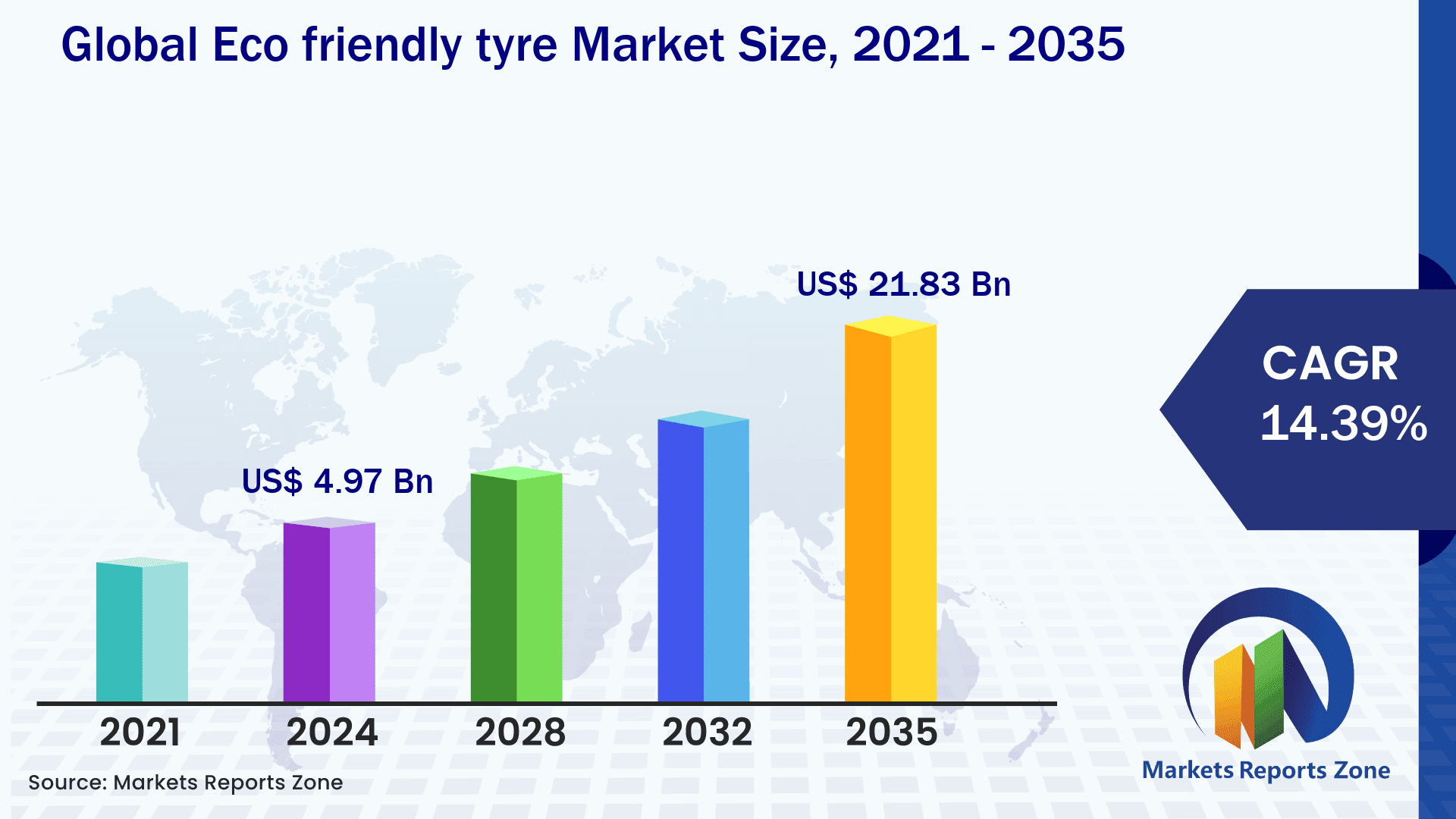Global Eco friendly tyre Market Size is expected to reach USD 21.83 Billion by 2035 from USD 4.97 Billion in 2024, with a CAGR of around 14.39% between 2024 and 2035. The global eco-friendly tire market is growing due to sustainability initiatives and fuel efficiency demands. Stringent environmental regulations have pushed manufacturers to develop low-emission, biodegradable, and energy-efficient tires. Brands like Michelin and Bridgestone have launched sustainable tire lines using recycled materials and bio-based compounds. Rising electric vehicle adoption has also driven demand, as EVs require low rolling resistance tires for better range and performance. Companies like Goodyear have introduced specialized tires to maximize battery efficiency. However, high production costs remain a restraint, as advanced materials and R&D investments increase overall expenses. This has limited affordability, especially in price-sensitive markets. Despite challenges, significant opportunities exist. Advancements in sustainable materials have enabled the development of high-performance eco-friendly tires with durability matching traditional options. Manufacturers like Continental are exploring dandelion rubber and silica-based compounds for improved efficiency. Government incentives and green initiatives are also promoting the shift toward sustainable mobility. Many nations are supporting research and development, accelerating the adoption of environmentally friendly tires in both passenger and commercial vehicle segments. As consumer awareness grows, demand for eco-friendly tires is expected to rise, with innovation and regulatory support playing crucial roles in market expansion.

Driver: Electric Vehicles Driving Green Tire Demand
The rapid adoption of electric vehicles (EVs) has increased the demand for eco-friendly tires designed to enhance efficiency and performance. Unlike traditional cars, EVs require tires with low rolling resistance to maximize battery range and reduce energy consumption. To meet this need, manufacturers have introduced advanced tire technologies tailored for EVs. Pirelli developed special EV tires with improved grip and noise reduction, optimizing energy use while maintaining safety. Similarly, Hankook launched its iON tire series, featuring sustainable materials and high durability to handle the extra weight of EV batteries. Automakers are also collaborating with tire companies to ensure better efficiency. Tesla equips its models with tires optimized for aerodynamics and reduced road friction, extending driving range. Meanwhile, Nissan introduced eco-friendly tires in its Leaf model, incorporating silica compounds to enhance energy efficiency. Beyond performance, sustainability remains a key focus, with brands experimenting with recycled rubber, plant-based oils, and biodegradable components to minimize environmental impact. As EV sales continue rising globally, the need for specialized, eco-friendly tires will grow, pushing tire manufacturers to innovate further. The synergy between EV expansion and green tire technology is shaping the future of sustainable mobility.
Key Insights:
- The adoption rate of eco-friendly tires in the passenger vehicle segment has surpassed 25% in some developed markets, driven by sustainability regulations.
- A major tire manufacturer has invested over $500 million in research and development for sustainable tire materials, including recycled and bio-based components.
- More than 1.2 million units of eco-friendly tires were sold last year for electric vehicles, reflecting growing demand in the EV segment.
- The penetration rate of sustainable tires in the commercial vehicle industry remains below 10%, but fleet operators are gradually shifting to low-resistance, fuel-efficient options.
- Government initiatives promoting green mobility have allocated over $1 billion in incentives and subsidies to encourage the adoption of eco-friendly tires.
- A leading automaker has committed to using 100% sustainable tires in all its electric models by 2030, aligning with its carbon-neutral targets.
- The share of natural and recycled materials in premium tire production has reached up to 40%, with some companies aiming for full sustainability by 2050.
- The demand for eco-friendly retreaded tires has increased by nearly 15% year-over-year, reducing waste and extending tire life in commercial applications.
Segment Analysis:
The eco-friendly tire market is expanding across various types and applications, driven by sustainability goals and fuel efficiency requirements. All-steel tires are widely used in heavy-duty applications, offering durability and lower rolling resistance for long-haul commercial trucks. Brands like Michelin and Bridgestone have introduced all-steel radial tires with advanced tread compounds that reduce fuel consumption and carbon emissions. Semi-steel tires, commonly found in passenger and light commercial vehicles, provide a balance between durability and ride comfort. Companies like Continental and Goodyear are using sustainable raw materials, such as soybean oil and recycled rubber, to manufacture these tires without compromising performance. In terms of application, passenger vehicles are witnessing a shift toward eco-friendly tires, with automakers equipping electric and hybrid models with low-resistance designs to improve battery efficiency. For example, Volkswagen's ID.4 features tires made with renewable materials, enhancing both sustainability and performance. Light commercial vehicles, including delivery vans and small trucks, are also adopting fuel-efficient tires to reduce operating costs. Ford’s electric Transit van now comes with energy-saving tires to extend driving range. Heavy commercial vehicles, such as freight trucks and buses, are transitioning to durable eco-friendly tires, with logistics companies increasingly opting for retreaded and bio-based rubber options to cut emissions and enhance sustainability.
Regional Analysis:
The eco-friendly tire market is expanding globally, with each region experiencing growth driven by sustainability initiatives and regulatory shifts. North America is witnessing increased adoption due to stringent emissions regulations and rising electric vehicle sales. Companies like Goodyear have introduced sustainable tire lines using soybean oil and recycled materials, catering to both passenger and commercial segments. Europe remains a leader in green mobility, with manufacturers like Pirelli developing tires made from bio-based rubber and silica compounds. The push for carbon neutrality has led to stricter regulations, encouraging fleet operators to switch to fuel-efficient tires. Asia-Pacific is experiencing strong demand, driven by rapid urbanization and government incentives promoting green transportation. Automakers in Japan and South Korea, such as Toyota and Hyundai, are collaborating with tire companies to integrate eco-friendly solutions into their electric and hybrid models. The Middle East is gradually adopting sustainable tires, particularly in high-performance and commercial vehicle sectors, with premium brands introducing temperature-resistant, fuel-efficient options suited for extreme climates. Latin America is embracing eco-friendly tires as part of its sustainability drive, with companies like Bridgestone investing in renewable rubber plantations to reduce dependency on synthetic materials. As awareness grows, global adoption of green tires is set to accelerate further.
Competitive Scenario:
Leading tire manufacturers are advancing eco-friendly solutions to meet growing sustainability demands across all segments. Michelin and Bridgestone are investing heavily in bio-based and recycled materials, with recent innovations including tires made from dandelion rubber and recovered carbon black. Continental and Pirelli have introduced performance-driven eco-friendly tires, incorporating silica compounds and plant-based oils to enhance fuel efficiency while maintaining durability. Goodyear has launched tires made with soybean oil, improving flexibility and reducing petroleum dependency. Asian manufacturers are also making significant strides. Shanghai Huayi and ZC Rubber are focusing on low rolling resistance designs for electric and hybrid vehicles, catering to rising demand in China. Sumitomo Rubber and Yokohama have developed tires with advanced tread technology, reducing road friction to maximize energy efficiency. Nokian Tyres has pioneered all-weather sustainable tires, suitable for harsh climates, integrating recycled steel and renewable rubber. Hankook and Maxxis have expanded their product lines to include ultra-durable, lightweight eco-friendly options tailored for electric and commercial vehicles. Triangle Group is strengthening its position by introducing retreadable tire solutions, minimizing waste and extending product life cycles. As competition grows, continuous innovation is driving the shift toward a greener tire industry.
Eco friendly tyre Market Report Scope
| Report Attribute | Details |
|---|
| Market Size Value in 2024 | USD 4.97 Billion |
| Revenue Forecast in 2035 | USD 21.83 Billion |
| Growth Rate | CAGR of 14.39% from 2025 to 2035 |
| Historic Period | 2021 - 2024 |
| Forecasted Period | 2025 - 2035 |
| Report Coverage | Revenue forecast, company ranking, competitive landscape, growth factors, and trends |
| Regions Covered | North America; Europe; Asia Pacific; Latin America; Middle East & Africa |
| Countries Covered | U.S.; Canada; Mexico, UK; Germany; France; Spain; Italy; Russia; China; Japan; India; South Korea; Australia; Southeast Asia; Brazil; Argentina; Saudi Arabia; UAE; South Africa |
| Key companies profiled | Michelin; Bridgestone; Continental; Pirelli; Goodyear; Shanghai Huayi; Sumitomo Rubber Industries; ZC Rubber; Yokohama; Nokian Tyres; Hankook; Maxxis; Triangle Group |
| Customization | Free report customization (equivalent up to 8 analysts working days) with purchase. Addition or alteration to country, regional & segment scope. |
The Global Eco friendly tyre Market report is segmented as follows:
By Type,
By Application,
- Passenger Vehicle
- Light Commercial Vehicle
- Heavy Commercial Vehicle
By Region,
- North America
- Europe
- UK
- Germany
- France
- Spain
- Italy
- Russia
- Rest of Europe
- Asia Pacific
- China
- Japan
- India
- South Korea
- Australia
- Southeast Asia
- Rest of Asia Pacific
- Latin America
- Brazil
- Argentina
- Rest of Latin America
- Middle East & Africa
- Saudi Arabia
- UAE
- South Africa
- Rest of Middle East and Africa
Key Market Players,
- Michelin
- Bridgestone
- Continental
- Pirelli
- Goodyear
- Shanghai Huayi
- Sumitomo Rubber Industries
- ZC Rubber
- Yokohama
- Nokian Tyres
- Hankook
- Maxxis
- Triangle Group
Frequently Asked Questions
Global Eco friendly tyre Market Size was valued at USD 4.97 Billion in 2024 and is projected to reach at USD 21.83 Billion in 2035.
Global Eco friendly tyre Market is expected to grow at a CAGR of around 14.39% during the forecasted year.
North America, Asia Pacific and Europe are major regions in the global Eco friendly tyre Market.
Key players analyzed in the global Eco friendly tyre Market are Michelin; Bridgestone; Continental; Pirelli; Goodyear; Shanghai Huayi; Sumitomo Rubber Industries; ZC Rubber; Yokohama; Nokian Tyres; Hankook; Maxxis; Triangle Group and so on.
Research Objectives
- Proliferation and maturation of trade in the global Eco friendly tyre Market.
- The market share of the global Eco friendly tyre Market, supply and demand ratio, growth revenue, supply chain analysis, and business overview.
- Current and future market trends that are influencing the growth opportunities and growth rate of the global Eco friendly tyre Market.
- Feasibility study, new market insights, company profiles, investment return, market size of the global Eco friendly tyre Market.
Chapter 1 Eco friendly tyre Market Executive Summary
- 1.1 Eco friendly tyre Market Research Scope
- 1.2 Eco friendly tyre Market Estimates and Forecast (2021-2035)
- 1.2.1 Global Eco friendly tyre Market Value and Growth Rate (2021-2035)
- 1.2.2 Global Eco friendly tyre Market Price Trend (2021-2035)
- 1.3 Global Eco friendly tyre Market Value Comparison, by Type (2021-2035)
- 1.3.1 All-Steel
- 1.3.2 Semi-Steel
- 1.4 Global Eco friendly tyre Market Value Comparison, by Application (2021-2035)
- 1.4.1 Passenger Vehicle
- 1.4.2 Light Commercial Vehicle
- 1.4.3 Heavy Commercial Vehicle
Chapter 2 Research Methodology
- 2.1 Introduction
- 2.2 Data Capture Sources
- 2.2.1 Primary Sources
- 2.2.2 Secondary Sources
- 2.3 Market Size Estimation
- 2.4 Market Forecast
- 2.5 Assumptions and Limitations
Chapter 3 Market Dynamics
- 3.1 Market Trends
- 3.2 Opportunities and Drivers
- 3.3 Challenges
- 3.4 Market Restraints
- 3.5 Porter's Five Forces Analysis
Chapter 4 Supply Chain Analysis and Marketing Channels
- 4.1 Eco friendly tyre Supply Chain Analysis
- 4.2 Marketing Channels
- 4.3 Eco friendly tyre Suppliers List
- 4.4 Eco friendly tyre Distributors List
- 4.5 Eco friendly tyre Customers
Chapter 5 COVID-19 & Russia?Ukraine War Impact Analysis
- 5.1 COVID-19 Impact Analysis on Eco friendly tyre Market
- 5.2 Russia-Ukraine War Impact Analysis on Eco friendly tyre Market
Chapter 6 Eco friendly tyre Market Estimate and Forecast by Region
- 6.1 Global Eco friendly tyre Market Value by Region: 2021 VS 2023 VS 2035
- 6.2 Global Eco friendly tyre Market Scenario by Region (2021-2023)
- 6.2.1 Global Eco friendly tyre Market Value Share by Region (2021-2023)
- 6.3 Global Eco friendly tyre Market Forecast by Region (2024-2035)
- 6.3.1 Global Eco friendly tyre Market Value Forecast by Region (2024-2035)
- 6.4 Geographic Market Analysis: Market Facts and Figures
- 6.4.1 North America Eco friendly tyre Market Estimates and Projections (2021-2035)
- 6.4.2 Europe Eco friendly tyre Market Estimates and Projections (2021-2035)
- 6.4.3 Asia Pacific Eco friendly tyre Market Estimates and Projections (2021-2035)
- 6.4.4 Latin America Eco friendly tyre Market Estimates and Projections (2021-2035)
- 6.4.5 Middle East & Africa Eco friendly tyre Market Estimates and Projections (2021-2035)
Chapter 7 Global Eco friendly tyre Competition Landscape by Players
- 7.1 Global Top Eco friendly tyre Players by Value (2021-2023)
- 7.2 Eco friendly tyre Headquarters and Sales Region by Company
- 7.3 Company Recent Developments, Mergers & Acquisitions, and Expansion Plans
Chapter 8 Global Eco friendly tyre Market, by Type
- 8.1 Global Eco friendly tyre Market Value, by Type (2021-2035)
- 8.1.1 All-Steel
- 8.1.2 Semi-Steel
Chapter 9 Global Eco friendly tyre Market, by Application
- 9.1 Global Eco friendly tyre Market Value, by Application (2021-2035)
- 9.1.1 Passenger Vehicle
- 9.1.2 Light Commercial Vehicle
- 9.1.3 Heavy Commercial Vehicle
Chapter 10 North America Eco friendly tyre Market
- 10.1 Overview
- 10.2 North America Eco friendly tyre Market Value, by Country (2021-2035)
- 10.2.1 U.S.
- 10.2.2 Canada
- 10.2.3 Mexico
- 10.3 North America Eco friendly tyre Market Value, by Type (2021-2035)
- 10.3.1 All-Steel
- 10.3.2 Semi-Steel
- 10.4 North America Eco friendly tyre Market Value, by Application (2021-2035)
- 10.4.1 Passenger Vehicle
- 10.4.2 Light Commercial Vehicle
- 10.4.3 Heavy Commercial Vehicle
Chapter 11 Europe Eco friendly tyre Market
- 11.1 Overview
- 11.2 Europe Eco friendly tyre Market Value, by Country (2021-2035)
- 11.2.1 UK
- 11.2.2 Germany
- 11.2.3 France
- 11.2.4 Spain
- 11.2.5 Italy
- 11.2.6 Russia
- 11.2.7 Rest of Europe
- 11.3 Europe Eco friendly tyre Market Value, by Type (2021-2035)
- 11.3.1 All-Steel
- 11.3.2 Semi-Steel
- 11.4 Europe Eco friendly tyre Market Value, by Application (2021-2035)
- 11.4.1 Passenger Vehicle
- 11.4.2 Light Commercial Vehicle
- 11.4.3 Heavy Commercial Vehicle
Chapter 12 Asia Pacific Eco friendly tyre Market
- 12.1 Overview
- 12.2 Asia Pacific Eco friendly tyre Market Value, by Country (2021-2035)
- 12.2.1 China
- 12.2.2 Japan
- 12.2.3 India
- 12.2.4 South Korea
- 12.2.5 Australia
- 12.2.6 Southeast Asia
- 12.2.7 Rest of Asia Pacific
- 12.3 Asia Pacific Eco friendly tyre Market Value, by Type (2021-2035)
- 12.3.1 All-Steel
- 12.3.2 Semi-Steel
- 12.4 Asia Pacific Eco friendly tyre Market Value, by Application (2021-2035)
- 12.4.1 Passenger Vehicle
- 12.4.2 Light Commercial Vehicle
- 12.4.3 Heavy Commercial Vehicle
Chapter 13 Latin America Eco friendly tyre Market
- 13.1 Overview
- 13.2 Latin America Eco friendly tyre Market Value, by Country (2021-2035)
- 13.2.1 Brazil
- 13.2.2 Argentina
- 13.2.3 Rest of Latin America
- 13.3 Latin America Eco friendly tyre Market Value, by Type (2021-2035)
- 13.3.1 All-Steel
- 13.3.2 Semi-Steel
- 13.4 Latin America Eco friendly tyre Market Value, by Application (2021-2035)
- 13.4.1 Passenger Vehicle
- 13.4.2 Light Commercial Vehicle
- 13.4.3 Heavy Commercial Vehicle
Chapter 14 Middle East & Africa Eco friendly tyre Market
- 14.1 Overview
- 14.2 Middle East & Africa Eco friendly tyre Market Value, by Country (2021-2035)
- 14.2.1 Saudi Arabia
- 14.2.2 UAE
- 14.2.3 South Africa
- 14.2.4 Rest of Middle East & Africa
- 14.3 Middle East & Africa Eco friendly tyre Market Value, by Type (2021-2035)
- 14.3.1 All-Steel
- 14.3.2 Semi-Steel
- 14.4 Middle East & Africa Eco friendly tyre Market Value, by Application (2021-2035)
- 14.4.1 Passenger Vehicle
- 14.4.2 Light Commercial Vehicle
- 14.4.3 Heavy Commercial Vehicle
Chapter 15 Company Profiles and Market Share Analysis: (Business Overview, Market Share Analysis, Products/Services Offered, Recent Developments)
- 15.1 Michelin
- 15.2 Bridgestone
- 15.3 Continental
- 15.4 Pirelli
- 15.5 Goodyear
- 15.6 Shanghai Huayi
- 15.7 Sumitomo Rubber Industries
- 15.8 ZC Rubber
- 15.9 Yokohama
- 15.10 Nokian Tyres
- 15.11 Hankook
- 15.12 Maxxis
- 15.13 Triangle Group



